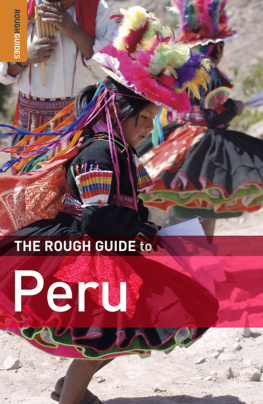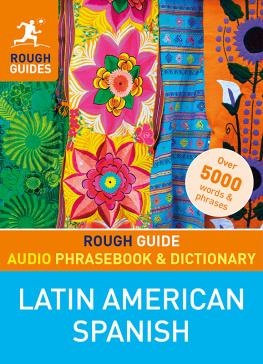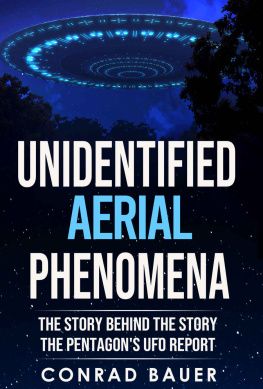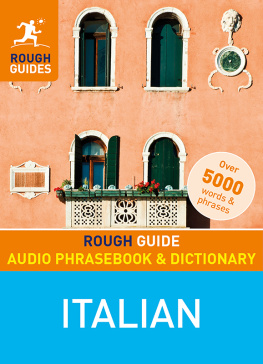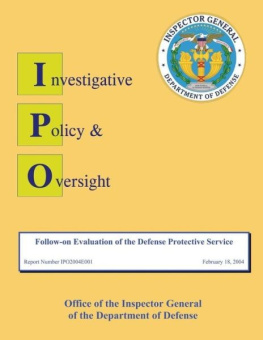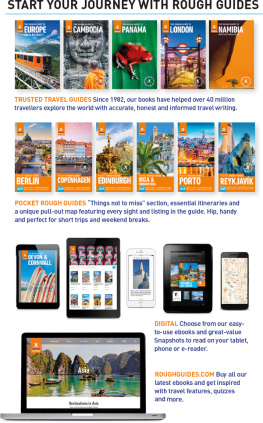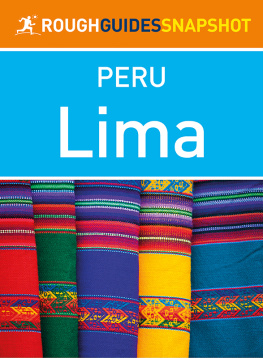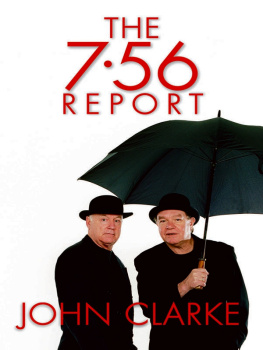Dilwyn Jenkins - The Rough Guide to Peru
Here you can read online Dilwyn Jenkins - The Rough Guide to Peru full text of the book (entire story) in english for free. Download pdf and epub, get meaning, cover and reviews about this ebook. year: 2011, publisher: Rough Guides, genre: Home and family. Description of the work, (preface) as well as reviews are available. Best literature library LitArk.com created for fans of good reading and offers a wide selection of genres:
Romance novel
Science fiction
Adventure
Detective
Science
History
Home and family
Prose
Art
Politics
Computer
Non-fiction
Religion
Business
Children
Humor
Choose a favorite category and find really read worthwhile books. Enjoy immersion in the world of imagination, feel the emotions of the characters or learn something new for yourself, make an fascinating discovery.
- Book:The Rough Guide to Peru
- Author:
- Publisher:Rough Guides
- Genre:
- Year:2011
- Rating:3 / 5
- Favourites:Add to favourites
- Your mark:
- 60
- 1
- 2
- 3
- 4
- 5
The Rough Guide to Peru: summary, description and annotation
We offer to read an annotation, description, summary or preface (depends on what the author of the book "The Rough Guide to Peru" wrote himself). If you haven't found the necessary information about the book — write in the comments, we will try to find it.
The Rough Guide to Peru — read online for free the complete book (whole text) full work
Below is the text of the book, divided by pages. System saving the place of the last page read, allows you to conveniently read the book "The Rough Guide to Peru" online for free, without having to search again every time where you left off. Put a bookmark, and you can go to the page where you finished reading at any time.
Font size:
Interval:
Bookmark:
This Rough Guide is one of a new generation of informative and easy-to-use travel-guide eBooks that guarantees you make the most of your visit before, during and after your stay. Use this eBook both to plan your trip and explore your destination when visiting. So, before you depart, check out the illustrated Introduction, plan your itinerary using the wealth of suggestions on offer, or simply browse the guide and be inspired.
The best way to explore this guide is to begin at the main table of contents. The first section of the eBook gives you a flavour of the destination, with must-see sights and suggested itineraries. This is followed by: the Basics essential practical information; the best sights, area by area; listings on everything from hotels and restaurants to festivals; and Contexts, the history of the destination and its presence in popular culture.
Shorter contents lists appear at the start of every section in the guide, and are designed to make chapter navigation quick and easy. You can jump back to these by tapping the chapter-heading links that sit with an arrow icon at the end of every article.
Every area of the destination has a clear and beautifully presented map. Depending on your hardware, you will be able to double-tap on the maps to see larger-scale versions fill your screen.
As you use this guide, youll notice that some entries are marked by a small Rough Guides running man icon; this denotes the authors picks. You can select your own favourites and create a personalized itinerary by bookmarking the sights, venues and activities that are of most interest, giving you the quickest possible access to everything youll need for your time away.
A fantastic land of gold, Peru was sixteenth-century Europes major source of treasure, and once the home of the largest empire in the world the sun-worshipping Incas. Since then, the riches of the Incas have fired the European imagination; the country was home to the worlds first stone pyramids, whose genuine antiquity was only discovered in the last few years of the twentieth century. The desert coast, meanwhile, is studded with monumental adobe temples and ruins from several pre-Inca civilizations. These archeological sites generate more than enough awe and wonder to attract visitors and pilgrims from all over the globe. Equally unique and appealing, however, is the sheer beauty of the countrys landscapes, the abundance of its wildlife, and the strong character of the people which has withstood a relatively recent, lengthy period of bloody political upheaval.
Peru is often visualized as a mountainous place, but thats not the whole story; in actual fact, its the most varied and exciting of all the South American nations, and many visitors remain unaware of the splendour of its desert coastline and vast tracts of tropical rainforest. Dividing these contrasting environments is a range of breathtaking peaks, the Andes, over six thousand metres high and four hundred kilometres wide in places, rippling the entire length of the country. So distinct are these three regions that it is very difficult to generalize about the country, but one thing is for sure: Peru offers unrivalled opportunities to experience an unusually wide range of spectacular scenery, as well as a wealth of human culture. Theres a rich diversity of music, dance and fiesta activity from every one of its distinctive regions, and Peruvian cuisine is some of the best in the Americas, partly because of the oceanic and tropical resources from which it draws.
The countrys natural resources were likewise motive enough for the Spanish conquistadors, whose fire-armed takeover the Incas and their native allies were unable to resist. Following the Conquest in the sixteenth century the colony developed by exploiting its Inca treasures, vast mineral deposits and the essentially slave labour which the colonists extracted from the indigenous people. After achieving independence from Spain in the early nineteenth century, Peru became a republic in traditional South American style, and although it is still very much dominated by the Spanish and mestizo descendants of the conquistadors leader, Francisco Pizarro, about half the population are of pure Indian blood. In many rural parts of the country, native life has changed little in the last four centuries. However, progress is gradually transforming much of Peru already most cities wear a distinctly Western aspect, and roads or tracks now connect almost every corner of the republic with the industrial cities that dominate the few fertile valleys along the coast. Only the Amazon jungle nearly two-thirds of Perus landmass, but home to a mere fraction of its population remains beyond the reach of Perus coastal markets, and even here oil and lumber companies, cocaine producers and settlers often think of themselves as being closer to Brazil and Colombia. Over the coming decade, however, the new Transoceanic road from Brazil may begin to erode this sense of isolation, at least in the southeast corner of the jungle region.
Despite it all, mundane, unaffected pleasures remain in place. The countrys prevailing attitude despite the sometimes hectic pace that permeates the capital, Lima is that there is always enough time for a chat, a ceviche, or another drink. Its a place where the resourceful and open-minded traveller can break through barriers of class, race and language far more easily than most of its inhabitants can; and also one in which the limousines and villas of the elite remain little more than a thin veneer on a nation whose roots lie firmly in its ethnic traditions and the earth itself.
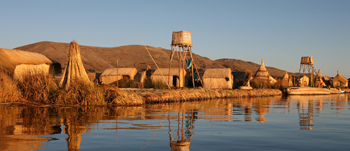
Uros Islands, Lake Titicaca
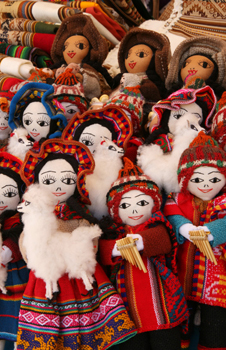
Market stall, Pisac
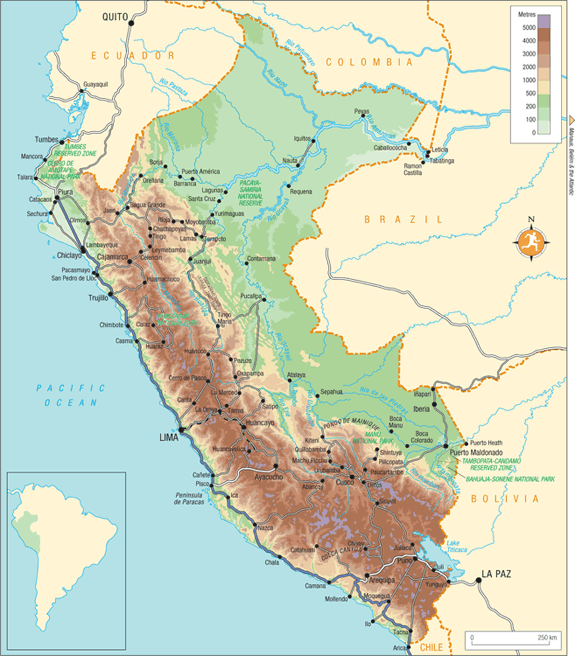
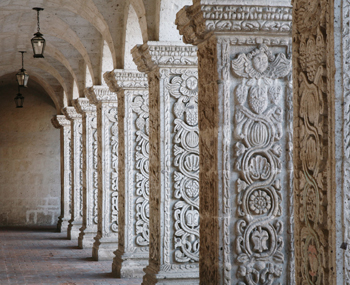
Ancient Peru developed several very important civilizations, both coastal (Paracas, Nasca, Mochica, Scan and Chimu) and Andean (Tiahuanaco, Chachapoyas, and, of course, the Incas). The Incas were easily and savagely defeated by the Spanish conquistadors in 1533. Peruvian independence was declared in 1821, with the remaining Spanish forces eventually defeated by the end of 1824.
The population of Peru today is almost 28 million, with 34 percent of the population presently below the age of 16. There are two official languages Spanish and Quechua but there are scores of other indigenous languages spoken here, including Aymara in the Southern Andes and numerous jungle Indian tribal languages.
The eleventh highest country in the world, Perus mountains reach 6768m above sea level in the Cordillera Blanca range. The Andes here are the highest mountain range anywhere in the tropics.
With 2414km of coastline, and well over half a million square kilometres of Amazon rainforest, Peru is also one of the most ecologically diverse countries in the world. Over 66 percent of Peru has forest or woodland cover, only 3 percent is arable land and around 21 percent permanent pasture. The coast is an unusually dry desert; east of the Andes the Amazon rainforest stretches thousands of miles beyond Peru, all the way to the Atlantic.
Font size:
Interval:
Bookmark:
Similar books «The Rough Guide to Peru»
Look at similar books to The Rough Guide to Peru. We have selected literature similar in name and meaning in the hope of providing readers with more options to find new, interesting, not yet read works.
Discussion, reviews of the book The Rough Guide to Peru and just readers' own opinions. Leave your comments, write what you think about the work, its meaning or the main characters. Specify what exactly you liked and what you didn't like, and why you think so.

